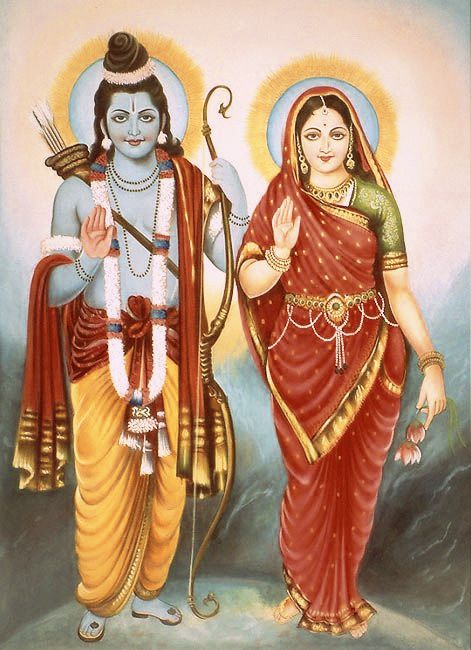
On the ninth day of the bright fortnight of the month of Chaitra in Treta Yuga, Lord Ramachandra appeared in Ayodhya, a city in northern India. This day has since been celebrated by the entire world as Ram Navami. The ninth canto of Bhagavata Purana states that Lord Ramachandra was born in the dynasty of Maharaja Khatvanga. The son of Maharaja Khatvanga was Dirghabahu and his son was Raghu. Aja was the son of Raghu and the son of Aja was Dasaratha. Lord Ramachandra was the son of Dasaratha and mother Kaushalya. King Dasarath had three wives – Kaushalya, Kaikeyi, and Sumitra. Ramachandra was none other than Vishnu, the Supreme Lord and He had descended into this world along with His full quadruple expansion – as Lord Rama, and brothers Lakshmana, Bharata, and Shatrughna. Bharata was the son of Kaikeyi while Lakshmana and Shatrughna were the sons of Sumitra.
Of all the brothers, Ramachandra was especially glorious. His body possessed a hue of celestial emerald. He was devoted to His father’s service. He quickly mastered the science of archery, horseback, and elephant riding, as well as various methods of driving a chariot. Lakshmana, since his childhood, was very attached to his elder brother Rama and pleased Him in every way. Shatrughna was just as dear to Bharata and these two brothers were also inseparable.
Lord Rama travels with sage Visvamitra to kill Rakshasas
One day sage Visvamitra arrived at King Dasaratha’s palace where he was warmly greeted. The sage described to the King how two rakshasas Maricha and Subahu repeatedly impeded the execution of his Yajnas (sacrifices). Every time his sacrifice neared completion, the demons ruined it by dropping flesh and blood into the sacred sacrificial arena.
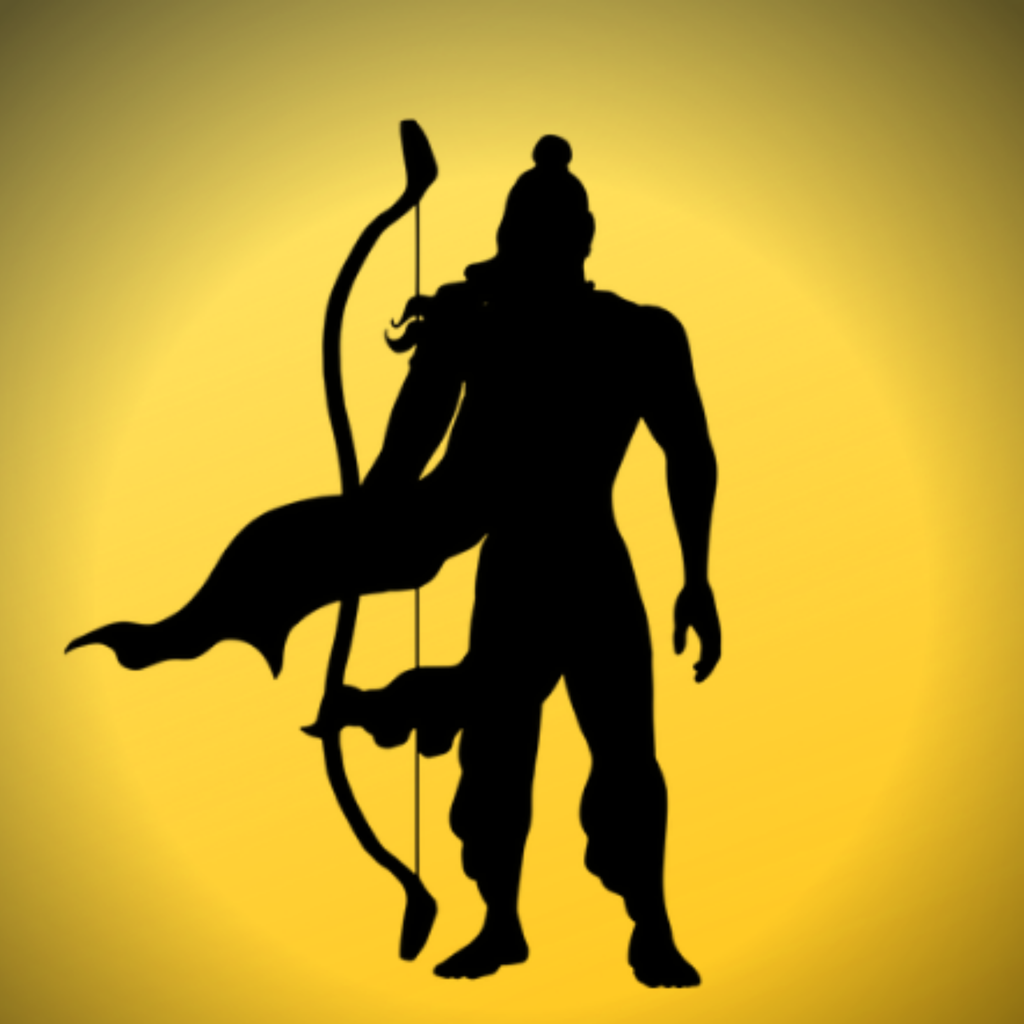
Hence he requested King Dasaratha to send Ramachandra with him for ten days so that the young prince can vanquish the demons who impeded the peaceful life of the sages. The King was shocked to hear the sage’s request. Although young Rama was a brave and an expert warrior, He had no previous experience of fighting on the battlefield. On the other hand, the Rakshasas knew every kind of sorcery. They could contend even with the Gods. Seeing the King anxious, sage Vivamitra reassured him that no harm would befall the prince and requested the king to grant his request. Actually, sage Visvamitra was aware that Rama was none other than the supreme Lord. He also understood that the annihilation of demons was one of the reasons why the Lord had incarnated. Hence the sage only acted as an instrument of the Lord’s will. King Dasaratha was mortified and even fell unconscious fearing for his son’s life. Finally, on the advice of sage Vasistha, the King relented. As Lakshmana would not leave his brother alone, both Rama and Lakshmana sought their leave and departed with sage Visvamitra.
Rama and Lakshmana slay the Rakshasas
Reaching the confluence of rivers Sarayu and Ganges, Rama and Lakshmana were welcomed by a community of ascetics. Sage Visvamitra recounted how Cupid was once punished by Lord Shiva at this same place, a long time ago. Cupid had fired his arrows of love at Lord Shiva, in order to spoil his meditation. Shiva became infuriated and burned cupid to ashes with his third eye. The next morning, the princes and the sages crossed over the Ganges to reach a vast desolate region that was infested with demons and beasts. Visvamitra described how two beautiful kingdoms once existed in that place. But it was now plagued by a Yaksha named ‘Tataka’ who was as powerful as thousands of elephants and could assume any form she desired. She ravaged the land and made it uninhabitable. Rama was initially reluctant to fight with Tataka, as after all, she was a woman. However, Sage Visvamitra convinced Him by citing historical examples of Kings and Gods who had acted similarly for the good of society. The sage explained that Tataka was a Yaksha who killed humans, and therefore deserved to be killed.
A violent fight ensued in which Tataka continuously changed her form and attacked the brothers Rama and Lakshmana from all sides. With her mystic powers of illusion, she employed numerous conjuring tricks. She hurled rocks, and boulders toward the brothers and screamed ferociously. Rama showed His skills of archery and parried the rocks with a shower of shafts from His bow. Finally, Rama fired an arrow imbued with the energy of a thunderbolt. It hit the Rakshasi in her chest, ripping her heart. She gave out a hideous cry and fell down dead. Having watched this marvelous feat, the demigods assembled in the sky and showered celestial flowers upon the two princes.

The next day the sage led the princes to a different place where he imparted unto them the knowledge of celestial weapons. Although possessing infinite knowledge, Rama and Lakshmana fully assumed the role of Vivamitra’s students. On the sixth night, the sages commenced with their sacrifices (yajnas). As expected, the two rakshasas Maricha and Subahu, along with other Rakshasas, assailed the sacrificial arena. As Rama attacked them with swift arrows, the Rakshasas became stunned as they did not expect any resistance. A violent fight ensued. Finally, Rama invoked the Manava weapon (presided over by Manu, father of mankind) which struck Maricha and threw him 800 miles away into the ocean. The other demons hurled lances, iron maces, massive rocks, and blazing coals at the two princes. Evading their rocks, Rama invoked the Agni weapon which struck Subahu in his heart. The demon’s heart was torn apart and he fell dead on the ground like an uprooted tree. Once Maricha and Subahu were taken care of, Rama fired the Vayu weapon which blew away the remaining Rakshasas like pieces of dust and debris. The sages were delighted and resumed their sacrifices peacefully.
The Marriage of Lord Rama and Sita
The following day, Visvamitra muni intimated the two princes of a sacrifice to be performed by King Janaka of Mithila. King Janaka owned a magnificent bow whose strength was inestimable. The bow was originally owned by Lord Shiva and it could not be bent even by the demigods, what to speak of humans. Janaka Maharaja had declared that any person who could bend the bow would win the hand of his daughter Sita. Sita was a veritable jewel among women and was born of mother earth herself. Visvamitra Muni suggested that they leave for Mithila at that very moment.
Sage Visvamitra, Rama, and Lakshmana received a warm welcome at Mithila. King Janaka personally greeted his guests accompanied by priests and counselors. The following morning King Janaka narrated the history of the bow. In the former ages, the concerned bow belonged to Lord Shiva. Shive once became angry with the demigods when they had denied him a share of the sacrificial offerings made by the sages. Shiva threatened the demigods and challenged them to fight. The demigods then came back to their senses and began worshiping Lord Shiva. Being pleased with the demigods, Shiva gifted them that bow. The famous bow was then given by the demigods to Janaka’s ancestor, Devarata after he had fought in a battle against the demons. It had since been kept in the king’s family, being worshiped as if it were Shiva himself. Many proud kings have since tried and failed to string the mighty bow, with a desire to win Sita’s hand in marriage.
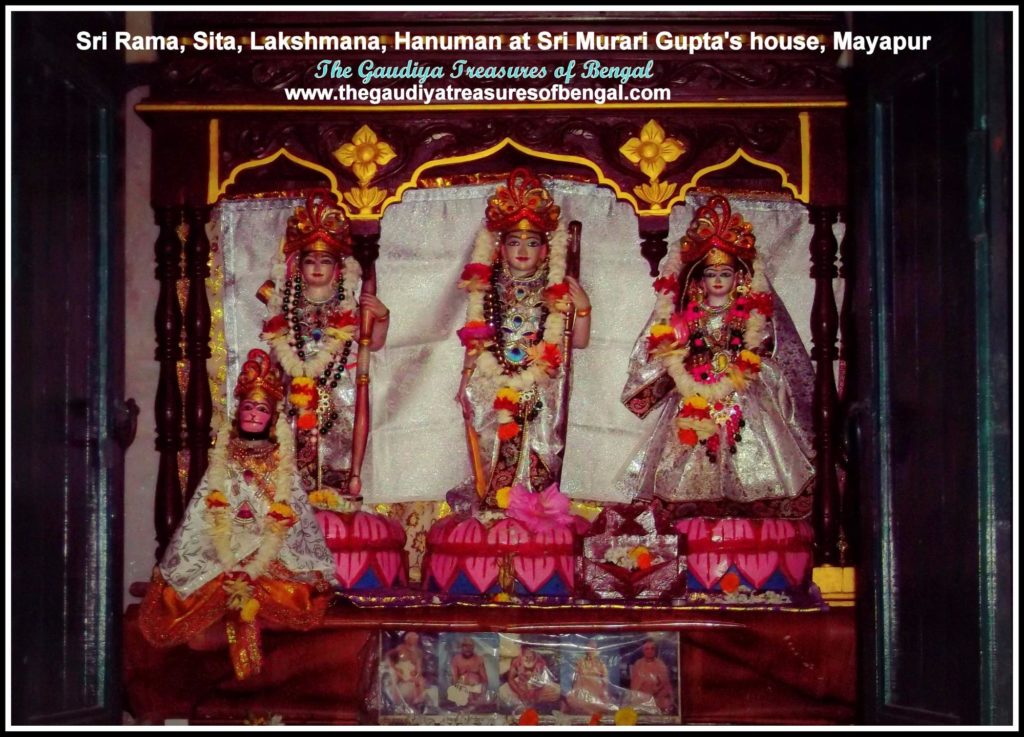
Sita stood on the balcony of the hall and felt a natural attraction toward Rama. Until then, She had never been interested in any of Her suitors as they were arrogant and overly proud. She was deeply religious and always prayed that Vishnu might become Her husband. She wondered whether Rama was Vishnu Himself. She hoped that Rama could string the bow and win Her hand. Three hundred powerfully built men dragged the chest containing the bow to the center of the hall. As the lid was opened, the brilliant bow, which was constructed with pure horn and that depicted pastimes of Gods in gold and silver, was displayed. The bow was studded with diamonds and other gems. Rama bowed before the bow in respect, and after taking permission from Visvamitra, seized the bow by its middle and raised it high above His head. It was an inconceivable feat and the entire hall stood in astonishment. Placing one end of the colossal bow on the ground, Rama strung the other end and pulled the string. The bow bent into a semi-circle. All of a sudden the bow broke, and a sound of thunder reverberated around the hall, rendering everyone senseless for a few moments. Everyone including Janaka Maharaja was amazed. Till now no other King was able to move the bow even slightly till now. However, Rama held it like it was a piece of bamboo. King Janaka was very happy to hand over Sita, his daughter, to Rama in marriage.
Sita came down from the balcony and stood with a garland of golden flowers in Her hands. She appeared mesmerizing in a deep maroon silk saree. Her neck was adorned with a necklace of pearls. As she walked, Her golden anklets tinkled and Her diamond earrings swung to and fro. As Her eyes met with Rama, both felt their hearts moved by love. At that moment their union was forged. Sita garlanded Rama, indicating Her acceptance of Him as husband. She blushed and kept Her eyes down. Messengers were dispatched to Ayodhya. King Dasaratha was overwhelmed with joy to learn that Rama and Lakshmana had conquered the demons and were doing well. He felt delighted to learn that Rama had now also won the beautiful Sita for His bride. Reaching Mithila, Dasaratha and Janaka Maharaja embraced each other. King Janaka shared the prophecy that he had heard from Narada Muni. Narada had previously informed him that Sita was Vishnu’s eternal consort and that one day the Supreme Lord would become Her husband in this world. It is for this reason, that Janaka Maharaja had devised a test that would only be possible for Vishnu to pass.
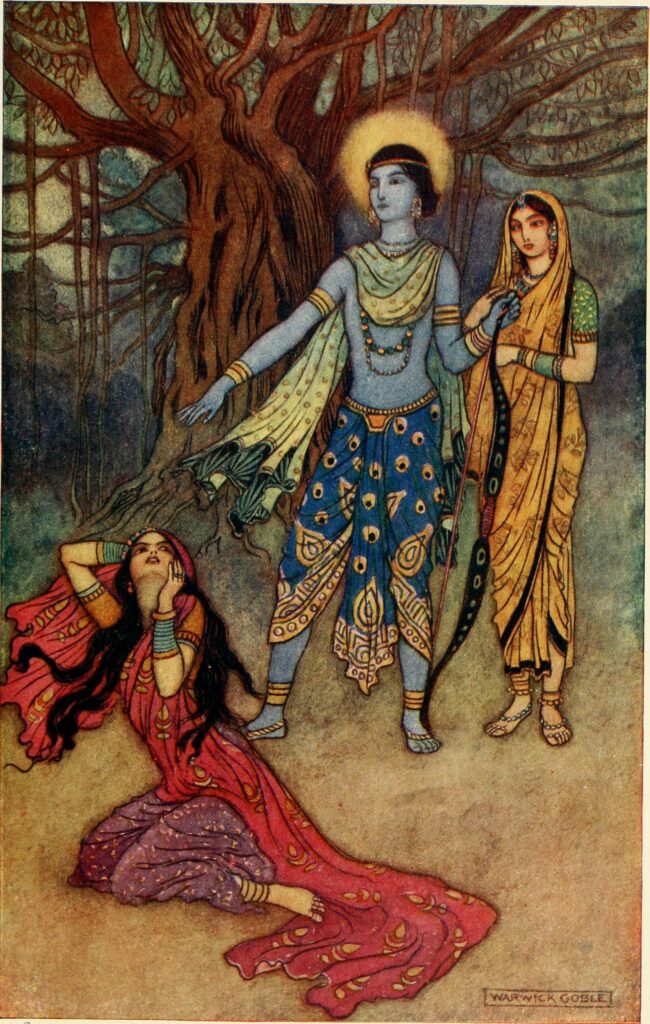
Sage Visvamitra suggested that Sita’s sister Urmila wed Lakhsmana while Janaka’s brother Kushadhvaja allows his two daughters Mandavi and Srutakirti to marry Bharata and Shatrughna respectively. Janaka was overjoyed with the proposal. Accordingly, there was a grand ceremony held at Mithila where all the four marriages took place simultaneously. Cries of happiness filled the entire place. The demigods played on their celestial drums, the apsaras danced, and Gandharvas sang while the sages recited Vedic texts. Everyone was lost in ecstasy.
Lord Rama destroys the pride of Parashurama
After spending a few days at Mithila, King Dasaratha proceeded toward Ayodhya along with his sons and daughters-in-law. A large army accompanied the procession. Suddenly a fierce tempest blew up, the earth shook while the sky was enveloped in complete darkness. These were the symptoms of impending grave danger. Suddenly from the darkness appeared the sage Parashurama. He was dressed in tiger skins and had matted locks at the crown of his head. All immediately recognized him. Parashurama was the empowered brahmin who had single-handedly annihilated millions of Kshatriyas being enraged at his father’s death at the hand of warriors. Parashurama was the fighter who had rid the world of its warriors’ twenty-one times. This time Parashurama challenged Lord Rama. He had heard of Rama breaking Shiva’s bow and had come to test His strength. Dasaratha and the other sages pleaded with him. Paying no attention to them, he informed Rama that he had another sacred bow in his possession. This bow belonged to Lord Vishnu and was more powerful than the previous one as Vishnu is always superior to Shiva. He challenged Rama to string that bow and draw it to its full length. If Rama was successful, he would challenge Him to a duel.
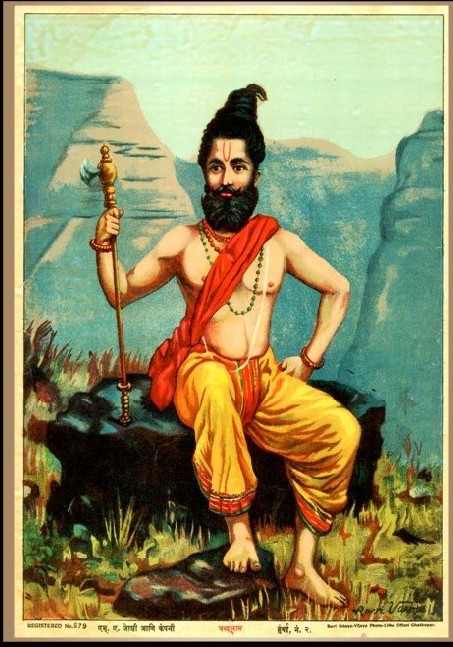
Lord Rama paid His respects unto the sage. He stepped forward and effortlessly strung the bow with a blazing arrow. Looking angrily at Parashurama, He asked, “Where shall I release this deadly shaft, O sage? As you are My superior I dare not aim it at you”. Fearing that the arrow might destroy the heavens, the demigods trembled with fear. Parashurama came back to his senses and realizing that Rama was none other than Vishnu, spoke apologetically. He recalled how Vishnu had informed him long back that He would come to take back the divine energy He had given to the sage. Parashurama praised Lord Rama and requested Him to aim the arrow at his pride and his desires for heavenly pleasures so that he becomes fit to serve Rama eternally. Bowing before Rama, the sage then vanished.
Rama is banished to the forest
Before long King Dasaratha wanted to install Rama on the throne of Ayodhya. The news of Rama’s impending coronation spread like wildfire and delighted everyone. Lord Rama was just, humble, mild, and self-controlled. He never acted without due consultation and was not influenced by envy or hatred. He recognized even the smallest service and was always vigilant to carry out His duty. Rama even delighted the demigods who frequently graced Ayodhya with their presence. He was as effulgent as the sun-god, as wise as Brihaspati, and as tolerant as mother earth.
However, this news was not received well by Manthara who was a hunch-backed maidservant of Kaikeyi, Dasaratha’s youngest queen. Manthara felt insecure and feared that as soon as Rama became the King, Kaikeyi and her son Bharata would lose relevance. As a result, other maidservants would joke about her and that she would lose the special privileges she had been enjoying, being a senior maidservant. When Kaikeyi heard about Rama becoming the next King of Ayodhya, she became very happy and wanted to reward Manthara for bringing the news. Kaikeyi loved Rama like her own son. She knew Rama to be very just and hence, she did not want to entertain Manthara’s fears. But Manthara insisted that Rama becoming the King would imply Kaikeyi and Bharata becoming bereft of all royal fortunes. Manthara was blinded by her own greed and envy. She craved a lofty position in the palace. Hence, she continued to beseech Kaikeyi in increasingly malicious tones. Slowly her words began poisoning Kaikeyi’s mind. Manthara reminded Kaikeyi of a couple of boons that Dasaratha had previously vowed to her. Long back Dasaratha had fought a war against demons alongside the demigods. He was famed as invincible and his chariot appeared to be facing ten directions simultaneously. The gods had therefore named him Dasaratha, or “ten chariots”. In that fight, Dasaratha was severely wounded and he lay unconscious on the battlefield. At that moment Kaikeyi had ridden out in a chariot and saved Dasaratha. Upon recovering, Dasaratha had offered a couple of boons to Kaikeyi, but she deferred them to a time when she might need them most. Manthara insisted that the time had arrived.

As instructed by Manthara, Kaikeyi lay on the bare floor of the sulking chamber, with her hairs in disarray and ornaments cast aside. With a face darkened with rage, she sobbed and waited for King Dasaratha. King Dasaratha was surprised and shocked to find his youngest queen in that state. He repeatedly asked for the cause of her concern. Finally, she revealed her mind to Dasaratha and asked for her two boons – Bharata be installed as the King of Ayodhya and for Rama to be banished to the forest for fourteen years. At first, Dasaratha could not believe his ears. He tried to counsel his queen and instill sense into her. He tried to plead to her good conscience. But Kaikeyi was adamant and threatened the King that he would bring infamy upon him and his family if he broke his vows. Dasaratha pleaded with her, assuring her that Rama loved her like her own mother and he would never wrong either her or Bharata. Even Bharata was very fond of Rama. Dasaratha warned her that he would not live for long if Rama was sent away. But all of the King’s words fell on deaf ears. Kaikeyi was uncompromising to have her way. Dasaratha even appealed that Bharata be made the new King but Rama should not be banished to the forest. But Kaikeyi could not be convinced. Dasaratha cursed Kaikeyi and finally decided to speak to Rama about his predicament.
When Rama entered Kaikeyi’s room, He found King Dasaratha dejected, distressed, and grief-stricken. On being asked, Kaikeyi revealed the entire story about her two boons. Rama did not yield to grief and happily agreed to depart to the forest, in order to honor His father’s words. Hearing this, wicked Kaikeyi jubilated. Dasaratha could not contain his grief and kept weeping. On the other hand, Rama consoled Kaushalya and Lakshmana and then proceeded to Sita’s quarters. Rama intimated to Sita the situation. He expressed that instead of being crowned, He was being banished to the forest for fourteen years. When Rama proposed that Sita stay back at Ayodhya, She became angry and demanded that She would accompany Him to the forest. Rama tried to explain the grave dangers of living in a forest and how it shall turn out to be uncomfortable for Sita. But Sita insisted that She would accompany Her husband whether it be heaven or hell. Finally, Rama agreed to take Sita with Him. Lakshmana who was standing outside the door also wanted to accompany his elder brother. Having distributed their wealth in charity, and bidding farewell to their relatives, Rama, Sita, and Lakshmana departed for the forest, plunging Ayodhya into despair.